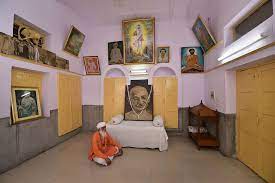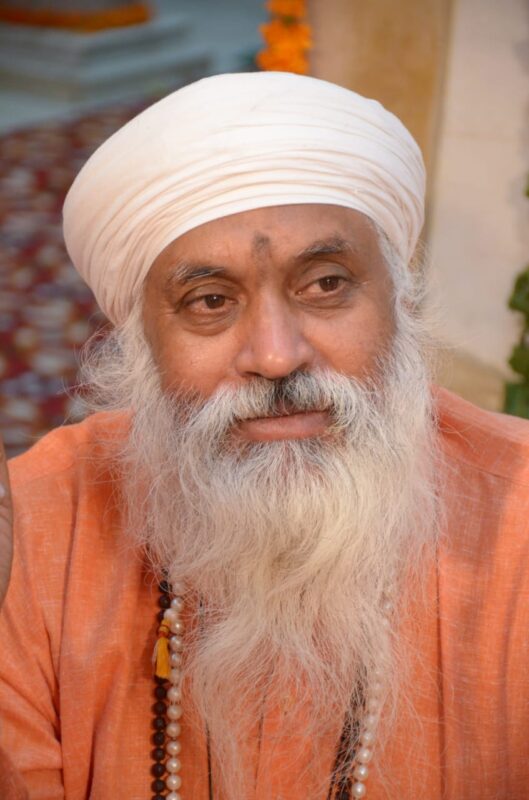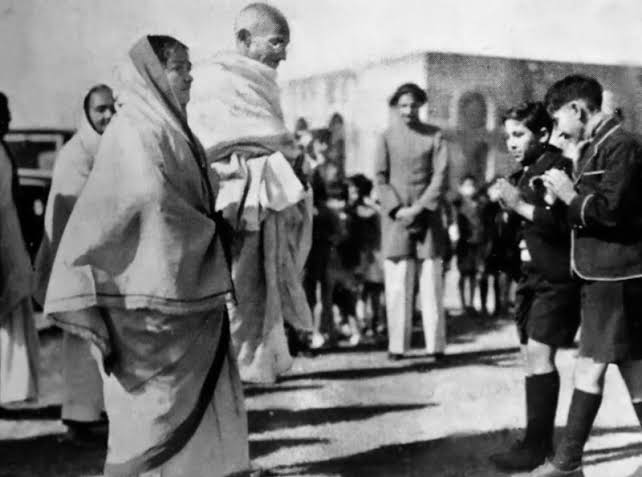For Krishan Vidyarthi, the caretaker and priest of Valmiki Temple on Mandir Marg (formerly Reading Road), the classroom inside the temple is a sacred place. He cleans the classroom, where his elders used to study more than 75 years ago, and the blackboard there daily without fail.
“Of course, this is not an ordinary classroom for Mahatma Gandhi used to teach his students here,” says Vidyarthi.
While the world knows Gandhi as an apostle of peace, leader of our freedom struggle and a social reformer, not many are aware that he served as a teacher to kids and their parents briefly.
He taught English and Hindi voluntarily when he started living at the Valmiki Temple. That was perhaps the first and only time when he became a teacher in the true sense of word.
When you visit Bapu’s carpeted room inside the Valmiki Temple, you would see several old sepia-coloured photographs of him with Lord Mountbatten and Lady Mountbatten, Acharya Kriplani, Frontier Gandhi Khan Abdul Ghaffar Khan, C Rajagopalachari, Sardar Patel, Maulana Azad and Jawaharlal Nehru.
One painting encapsulates the contribution of this venerable room.
In this painting, several kids are talking to Bapu in a very animated manner. Though the painter’s name is not there, he has done a wonderful job to reflect the mood in the room.
You would also find a wooden desk in the centre that Mahatma Gandhi used for writing, while on the right is his bed. Bapu’s charkha (cotton spinning wheel) is also there close to the bed. This charkha is small.
Everything in the room is in the position he left them behind.


OP Shukla, a Dalit activist whose father and brother were students of Gandhi, Says “Gandhi chose this place so that he could live with the ‘untouchables’. Those were the days when a very large number of Valmiki families used to live in jhuggis (slums) at the Valmiki colony close to the temple. They worked as sweepers in areas like Gole Market, Irwin Road (now Baba Kharak Singh Marg) and Connaught Place. He had deep empathy for my community.”
Many Valmiki families still live in these areas today, though now they own decent flats.
The jhuggies disappeared long ago. It is said that Mahatma Gandhi asked the elders of Valmiki colony in 1946 that he wanted to stay with them for a couple of months. They gladly agreed. Mahatma Gandhi stayed here for exactly 214 days, from April 1, 1946 to June 10, 1947.
“Once he moved to the Valmiki colony, he started interacting with Valmiki families. He was shocked to see that they were all illiterates. Nobody had even seen school.
Then he asked local residents to send their kids to him as he would teach them. The elders accepted Bapu’s offer and started sending their kids to his classes,” informs Vidyarthi.
Vidyarthi’s father and uncles also attended Bapu’s classes. Mahatma Gandhi wanted to teach them basic English and Hindi.
He ensured that his classes took place both in morning and evening without fail.
He was such a conscientious teacher that he often used to delay his meetings with stalwarts of freedom movement in order to finish his classes.
During his classes and later prayers, he didn’t meet guests.
Writes Louis Fischer in his biography of Gandhi, The Life of Mahatma, “Once I reached the Valmiki Temple from my hotel, Imperial, to interview him. But he met me only after the prayers.”
Fischer spent over one month in Delhi to collect notes for his biography on Bapu in 1946.
Mahatma Gandhi was a hard task-master. He used to chide students if any of them attended his class without taking a bath.
Not only the residents of Valmiki Colony, many students studying in schools like Harcourt Butler School, Raisina Bengali and Delhi Tamil Education Association School (DTEA) too attended his classes.
He didn’t charge anything from the students. It is said that he knew all the students by their names.
Though the lucky students of Bapu are not alive to narrate their experiences, their kids are still there to share Bapu’s stories as a teacher.
“It was a big blow for us when he was forced to shift from here to Birla House due to security reasons. Our elders were devastated. Alas, he was killed where security was tight,” Vidyarthi concludes.
“I grew up listening to stories of Gandhiji teaching at the Valmiki Temple from my father, who would narrate them to other members of the family. My father had attended his classes since during those days my family too lived close to Valmiki Temple,” says Shukla, who also taught at the Indian Law Institute.
“Thanks to Gandhiji, many members of my family became a little literate. The best thing about those classes was that many father-son or mother-daughter duo too used to attend them religiously.”

When Bapu began teaching at Valmiki Temple, kids of Gole market, Paharganj, Irwin Road and other areas close-by too started attending his classes.
The number of students kept swelling from around 30 at the start to around 75 each in morning and evening.
When numbers grew thick and fast, the classes began in an open area.
“As I am son of the soil of Valmiki colony, I can tell you that it was Bapu who taught our elders. They were all illiterates and came to Delhi from Meerut and other parts of western UP. But for him, they would have remained as they were.
Even after Bapu left Valmiki temple, his classes were continued. His students joined various schools in the Gole Market area,” adds Shukla.
VISITING DELHI’S OTHER INSTITUTIONS
Much before his classes at the Valmiki Temple, Mahatma Gandhi had visited the prestigious Modern School at the Barakhamba Road in 1935 at the invitation of Sardar Sobha Singh, head of the Modern School managing committee.
Sobha Singh was also the father of Khushwant Singh, who became a renowned journalist and writer post-independence.
A sepia-coloured picture of Bapu with students of Modern School is still there in the school principal’s room.

During his first visit to Delhi in 1915, Mahatma Gandhi stayed at the residence of St Stephen’s College principal, SK Rudra, inside the college campus in Kashmiri Gate.
“Rudra became a friend of Mahatma Gandhi thanks to CF Andrews, a teacher of St. Stephen’s College and an active member of Delhi Brotherhood Society (DBS),” says Father George Solomon of DBS that is actively doing social work in Delhi since the last 150 years.
A photograph recording Mahatma Gandhi first visit of Delhi on April 13-15, 1915 hangs in the principal’s office at St. Stephen’s College.
Mahatma Gandhi and Jamia Millia Islamia (JMI) are inseparable.
JMI was founded in 1920 during the Khilafat Movement and Non-Cooperation Movement in response to Mahatma Gandhi call for a boycott of all government-sponsored educational institutions.
JMI had the blessings of Gandhi at its inception. It was moved from Aligarh to Karol Bagh, Delhi, in 1925.
According to noted writer AGNoorani, “Jamia Millia Islamia was a product of India’s movement for freedom and was blessed by Gandhi at its very inception.”
Mahatma Gandhi sent his grandson Rasiklal to Jamia for his education. His youngest son, Devdas Gandhi taught English there too.





